The Cambridge History of China. Vol. 13: Republican China 1912-1949, Part 2
Подождите немного. Документ загружается.

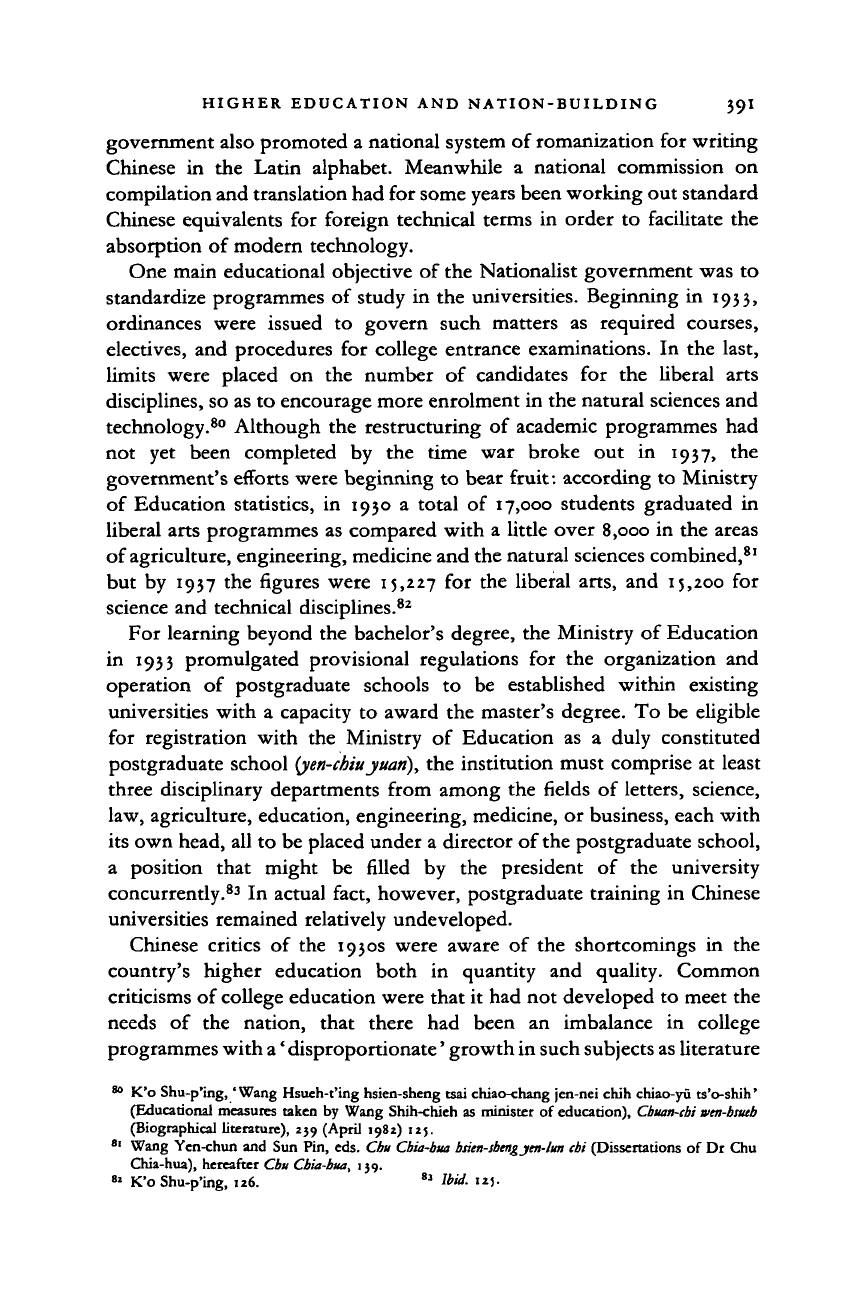
HIGHER EDUCATION AND NATION-BUILDING 39I
government also promoted a national system of romanization for writing
Chinese in the Latin alphabet. Meanwhile a national commission on
compilation and translation had for some years been working out standard
Chinese equivalents for foreign technical terms in order to facilitate the
absorption of modern technology.
One main educational objective of the Nationalist government was to
standardize programmes of study in the universities. Beginning in 1933,
ordinances were issued to govern such matters as required courses,
electives, and procedures for college entrance examinations. In the last,
limits were placed on the number of candidates for the liberal arts
disciplines, so as to encourage more enrolment in the natural sciences and
technology.
80
Although the restructuring of academic programmes had
not yet been completed by the time war broke out in 1937, the
government's efforts were beginning to bear fruit: according to Ministry
of Education statistics, in 1930 a total of 17,000 students graduated in
liberal arts programmes as compared with a little over
8,000
in the areas
of agriculture, engineering, medicine and the natural sciences combined,
81
but by 1937 the figures were 15,227 for the liberal arts, and 15,200 for
science and technical disciplines.
82
For learning beyond the bachelor's degree, the Ministry of Education
in 1933 promulgated provisional regulations for the organization and
operation of postgraduate schools to be established within existing
universities with a capacity to award the master's degree. To be eligible
for registration with the Ministry of Education as a duly constituted
postgraduate school
(jen-chiuyuan),
the institution must comprise at least
three disciplinary departments from among the fields of letters, science,
law, agriculture, education, engineering, medicine, or business, each with
its own head, all to be placed under a director of the postgraduate school,
a position that might be filled by the president of the university
concurrently.
83
In actual fact, however, postgraduate training in Chinese
universities remained relatively undeveloped.
Chinese critics of the 1930s were aware of the shortcomings in the
country's higher education both in quantity and quality. Common
criticisms of college education were that it had not developed to meet the
needs of the nation, that there had been an imbalance in college
programmes with a' disproportionate' growth in such subjects
as
literature
80
K'o Shu-p'ing,' Wang Hsueh-t'ing hsien-sheng tsai chiao-chang jen-nei chih chiao-yu ts'o-shih'
(Educational measures taken
by
Wang Shih-chieh
as
minister
of
education), Cbuan-cbi wtn-bsucb
(Biographical literature), 259 (April 1982) 125.
81
Wang Ycn-chun and Sun Pin, eds.
Cbu
Cbia-bua bsien-sbmgyen-lun
cbi
(Dissertations
of Dr
Chu
Chia-hua), hereafter Cbu Cbia-bua, 139.
82
K'o Shu-p'ing, 126.
83
ttid.
125.
Cambridge Histories Online © Cambridge University Press, 2008

39
2
THE
GROWTH
OF THE
ACADEMIC COMMUNITY
and
law
while science
and
technical subjects lagged behind,
and
that
funding
for
higher education
in
general was
far
from sufficient.
84
In
fact,
financing the colleges and universities from
a
variety
of
sources remained
difficult throughout the Nanking period.
In the
early 1920s
the
national
universities depended
on the
central government budget
for 90 per
cent
of their operating funds, with tuition and other fees and donations making
up less than
10 per
cent. While
the
central government budget
of
1934
stipulated that
15 per
cent
of
its annual expenditures should
be
assigned
to
the
support
of
education
and
cultural activities, that was
a
goal never
achieved
in
actuality;
in
1936,
for
example,
the
total amount budgeted
for education
and
culture stood
at a
high point
of
4-5
per
cent, while
military appropriations received 32-5 per cent and public debt service 24-1
per cent
in the
same year.
85
Compounding the problem for the national universities was the fact that
the central government, following the custom
of
earlier imperial regimes,
often assigned certain parts
of
a province's
tax
revenues
for the
support
of
a
national university located
in
that province; should
the
provincial
finances fall into disarray
for any
reason, payment
of
the allotted funds
to the university would become highly undependable.
86
Added to this was
the early lack
of a
uniform standard
on
which funding was
to be
based,
so that within
the
meagre total amount
of the
education budget
the
government's fairness might be called into question. Witness this petition
from the universities in Peking in 19 2 9:' Chung-shan University in Canton
and Central University
in
Nanking each
has a
student body
of 1,000 to
2,000,
and
each receives
a
monthly appropriation
of Ch.
$150,000
to
Ch. $160,000;
at
Peiping University there
are
seven colleges
and an
enrolment
of
3,500 students, yet the monthly appropriation
is
only some
Ch.
$90,000....'
8
?
Universities
and
colleges
at
the provincial level encountered still other
obstacles
in
getting public funding.
The
Nationalist government's effort
to centralize the national
finances
after
1929
was a long-drawn-out process.
In
the
collection
and
disbursement
of
tax monies, the procedures and
the
bureaucratic interrelationships
had to be
worked
out
between Nanking
84
Cbu Cbia-bm, 125, 138;
Ho
Ping-sung,'San-shih-wu-nien lai Chung-kuo chih ta-hsueh chiao-yii'
(Chinese higher education in the past
5 5
years),in Wan-Cb'itig, i3o;HuangChien-chung,'Shih-nien
ki
ti
Chung-kuo kao-teng chiao-yu' (Chinese higher education in the past ten years), in Kang-cban
cb'im sbib-nien
Mb
Chung-kuo (China
in
the decade before the war), 503.
85
Ch'en Neng-chih, 'Chan-ch'ien shih-nien Chung-kuo ta-hsueh chiao-yu ching-fei wen-t'i'
(Problems
of
financing higher education in China in the decade before the war),
U-sbib
bsueb-pao,
11 (June 1983) 173-6.
86
Ibid.
175-7. Examples
of
this condition
can
be
seen
in
the
cases
of
the National Chung-shan,
Wuhan, Chekiang, and Szechwan Universities from 1928
to
the early 1930s.
87
Ibid.
179.
Cambridge Histories Online © Cambridge University Press, 2008
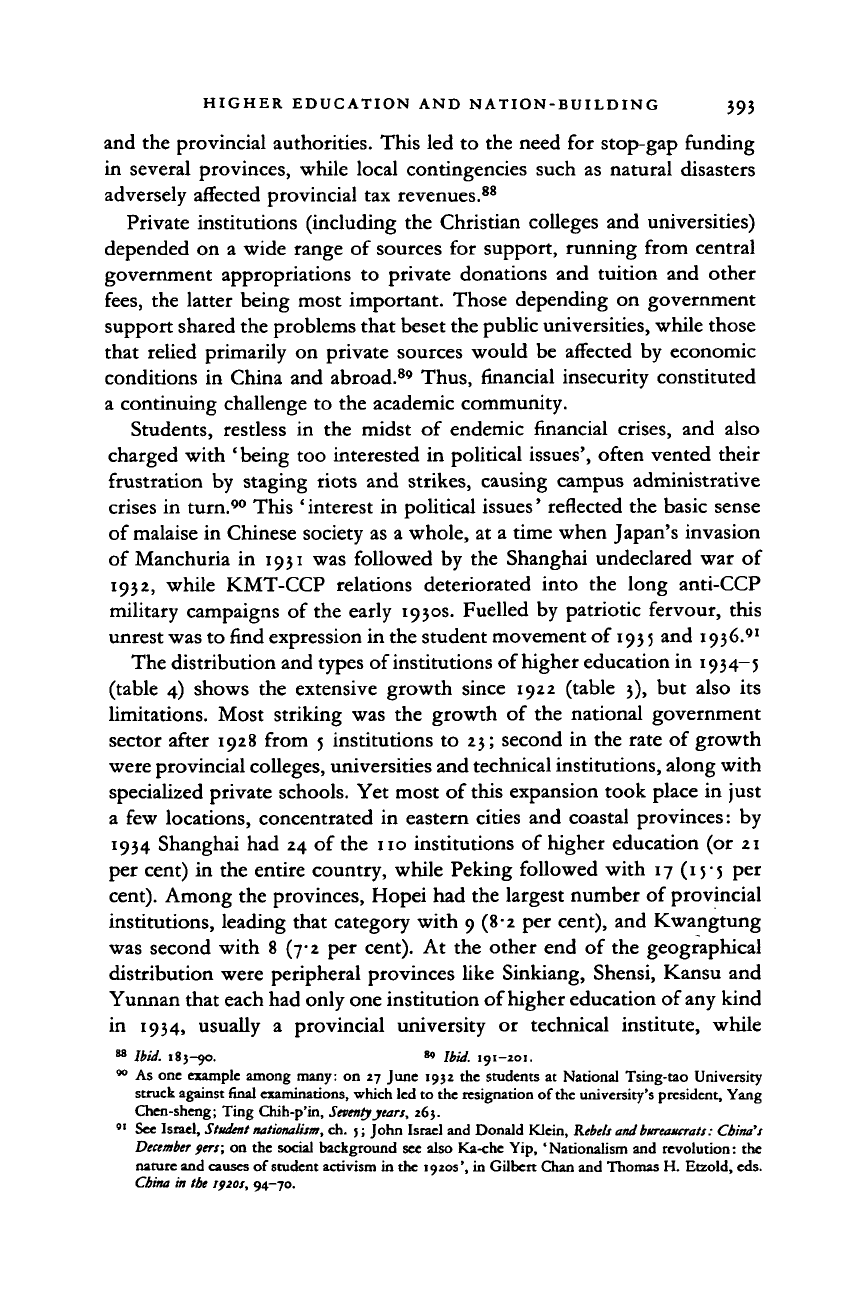
HIGHER EDUCATION AND NATION-BUILDING 393
and the provincial authorities. This led to the need for stop-gap funding
in several provinces, while local contingencies such as natural disasters
adversely affected provincial tax revenues.
88
Private institutions (including the Christian colleges and universities)
depended on a wide range of sources for support, running from central
government appropriations to private donations and tuition and other
fees,
the latter being most important. Those depending on government
support shared the problems that beset the public universities, while those
that relied primarily on private sources would be affected by economic
conditions in China and abroad.
89
Thus, financial insecurity constituted
a continuing challenge to the academic community.
Students, restless in the midst of endemic financial crises, and also
charged with ' being too interested in political issues', often vented their
frustration by staging riots and strikes, causing campus administrative
crises in turn.
90
This
'
interest in political issues' reflected the basic sense
of malaise in Chinese society as a whole, at a time when Japan's invasion
of Manchuria in 1931 was followed by the Shanghai undeclared war of
1932,
while KMT-CCP relations deteriorated into the long anti-CCP
military campaigns of the early 1930s. Fuelled by patriotic fervour, this
unrest was to find expression in the student movement of
1935
and 1936.
91
The distribution and types of institutions of higher education in 1934-5
(table 4) shows the extensive growth since 1922 (table 3), but also its
limitations. Most striking was the growth of the national government
sector after 1928 from 5 institutions to 23; second in the rate of growth
were provincial colleges, universities and technical institutions, along with
specialized private schools. Yet most of this expansion took place in just
a few locations, concentrated in eastern cities and coastal provinces: by
1934 Shanghai had 24 of the no institutions of higher education (or 21
per cent) in the entire country, while Peking followed with 17 (15-5 per
cent).
Among the provinces, Hopei had the largest number of provincial
institutions, leading that category with 9(8-2 per cent), and Kwangtung
was second with 8 (7-2 per cent). At the other end of the geographical
distribution were peripheral provinces like Sinkiang, Shensi, Kansu and
Yunnan that each had only one institution of higher education of any kind
in 1934, usually a provincial university or technical institute, while
88
Ibid.
185-90.
M
Ibid.
191-101.
°° As one example among many: on 27 June 1932 the students at National Tsing-tao University
struck against
final
examinations, which led to the resignation of
the
university's president, Yang
Chen-sheng; Ting Chih-p'in, Seventy years, 26}.
91
See Israel,
Student
nationalism,
ch. j; John Israel and Donald Klein,
Rebels and
bureaucrats:
China's
December
fers; on the social background see also Ka-che Yip, 'Nationalism and revolution: the
nature and causes of student activism in the 1920s', in Gilbert Chan and Thomas H. Etzold, eds.
China
m
the
if
20s,
94-70.
Cambridge Histories Online © Cambridge University Press, 2008
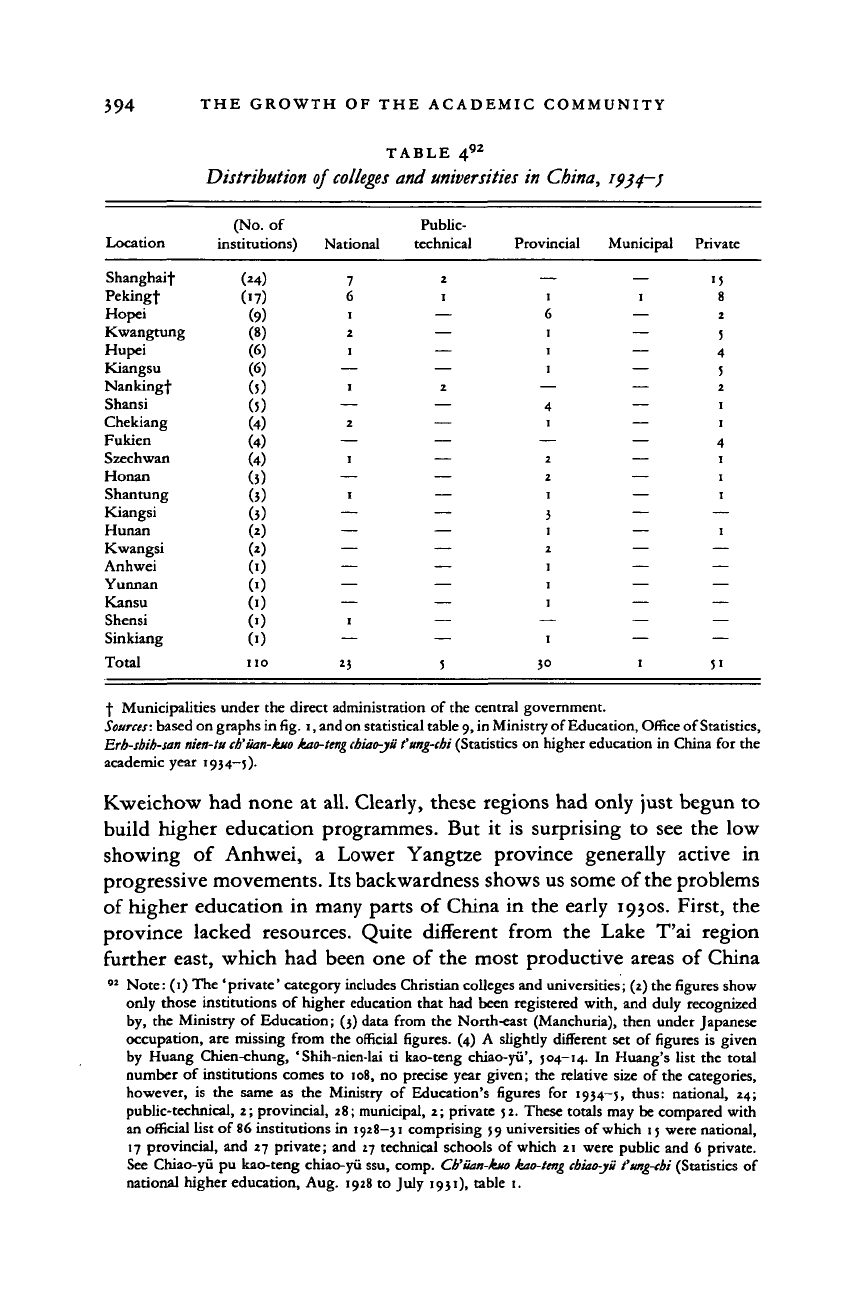
394
THE GROWTH OF THE ACADEMIC COMMUNITY
TABLE 4
92
Distribution of
colleges
and
universities
in China,
1934—/
Location
(No.
of
institutions)
National
Public-
technical Provincial Municipal Private
Shanghaif
Pekingf
Hopei
Kwangtung
Hupei
Kiangsu
Nankingf
Shansi
Chekiang
Fukien
Szechwan
Honan
Shantung
Kiangsi
Hunan
Kwangsi
Anhwei
Yunnan
Kansu
Shensi
Sinkiang
(M)
(17)
(9)
(8)
(6)
(6)
(5)
(5)
(4)
(4)
(4)
(3)
(3)
(3)
M
00
(0
(>)
(0
(0
(0
7
6
1
2
1
1
2
1
1
1
15
8
2
5
4
5
2
Total
3°
f Municipalities under the direct administration
of
the central government.
Sources:
based on graphs in
fig.
i,
and on
statistical table 9,
in
Ministry of Education, Office of Statistics,
Erb-sbib-san nien-tu
ch'uan-kuo
kao-teng
chiao-yu
fung-cbi (Statistics
on
higher education
in
China
for the
academic year 1934—5).
Kweichow had none
at
all. Clearly, these regions had only just begun
to
build higher education programmes.
But it is
surprising
to see the low
showing
of
Anhwei,
a
Lower Yangtze province generally active
in
progressive movements. Its backwardness shows us some of the problems
of higher education
in
many parts
of
China
in
the early 1930s. First,
the
province lacked resources. Quite different from
the
Lake
T'ai
region
further east, which
had
been one
of
the most productive areas
of
China
n
Note: (1) The 'private' category includes Christian colleges and universities; (2) the
figures
show
only those institutions
of
higher education that had been registered with, and duly recognized
by, the Ministry
of
Education
5(3)
data from the North-east (Manchuria), then under Japanese
occupation, are missing from the official figures.
(4) A
slightly different
set of
figures
is
given
by Huang Chien-chung, 'Shih-nien-lai
ti
kao-teng chiao-yu', 504-14.
In
Huang's list the total
number
of
institutions comes
to
108,
no
precise year given; the relative size
of
the categories,
however,
is the
same
as the
Ministry
of
Education's figures
for
1934—5, thus: national,
24;
public-technical, 2; provincial, 28; municipal, 2; private 52. These totals may be compared with
an official list
of
86 institutions in 1928—31 comprising 59 universities
of
which 15 were national,
17 provincial, and
27
private; and 27 technical schools
of
which 21 were public and
6
private.
See Chiao-yu
pu
kao-teng chiao-yu ssu, comp.
Ch'uan-kuo kao-teng cbiao-yu
t'ung-cbi
(Statistics
of
national higher education, Aug. 1928
to
July 1931), table
1.
Cambridge Histories Online © Cambridge University Press, 2008

HIGHER EDUCATION AND NATION-BUILDING 395
for many centuries, Anhwei was the poor sister
of
the Lower Yangtze
region with its hilly terrain traversed by the Huai River, cause of many
natural calamities. Anhwei's marginal economy precluded
any
rapid
development of higher education. A second factor was political instability
due
to
the struggle for power between provincial factions on one level,
and between the Nationalist authorities and local groups on another.
In
Anhwei volatile provincial politics created extreme instability: six changes
of governor between 1929 and 1930, with an extra bonus
of
a military
uprising,
led to
personnel turnovers
at the
provincial university;
moreover, the university received only about half its budgeted funds, since
higher education ranked low
at
the provincial capital.
93
Meanwhile,
to
make the situation more complex, the central government, attempting to
achieve real authority in Anhwei, began to integrate the provincial Anhwei
University with the national power structure through the KMT party
apparatus and a political education programme.
A further factor that could help explain Anhwei's poor showing
in
higher education was the considerable geographic mobility of the young
intelligentsia. Students everywhere move about,
the
more ambitious
tending to enter the better-known universities in other places if their local
institutions were deemed inadequate. Areas less well endowed would often
see their young students leaving
for the
larger centres.
A
less than
complete tabulation
of the
native provinces
of
Chinese college
and
university students
for
1934 reveals that
of
the 945 Anhwei students
registered nationwide, 44 per cent were attending national universities
outside the province, with another large segment scattered among private
and Christian colleges.
94
Finally there was also faculty mobility
on a
national scale. Wen I-to, for example, moved from place to place among
well-known institutions
in
Shanghai, Nanking, Wuchang and Tsingtao
in 1926-30, eventually settling
at
Tsing-hua University
in
1931.
The
reasons
for his
peripatetic existence were primarily
the
budgetary
difficulties of the colleges, and student unrest.
95
Chinese education was still a small show after a quarter century of the
republic.
The
national figure
for
student enrolment
in
colleges
and
universities stood at 42,710 in
1932-3,
and increased to
46,75 8
in
193
3~4.
96
93
Yang Liang-kung,
Ttao-cb'i san-sbih-nkn
ti
cbiao-bstub sbeng-buo
(My life as an educator: the first
50 years),
73—5.
Yang was president of the Provincial Anhwei University (1929-31), where the
student enrolment was about 400.
54
Ministry of Education, Office of Statistics,
Erb-ibib-san nicn-tu cb'uan-kuo kao-teng cbiao-jii fung-ebi
(Statistics
on
higher education
in
China
for the
academic year 1934—5),
100—1,
table
60.
Unfortunately no separate figure is shown for the student enrolment
at
the Provincial Anhwei
University alone.
« Liang Shih-ch'iu,
Tan
Wen l-to (About Wen I-to),
73-101.
06
K'o Shu-p'ing, 'Wang Hsueh-t'ing (Wang Shih-chieh)',
4.
Cambridge Histories Online © Cambridge University Press, 2008
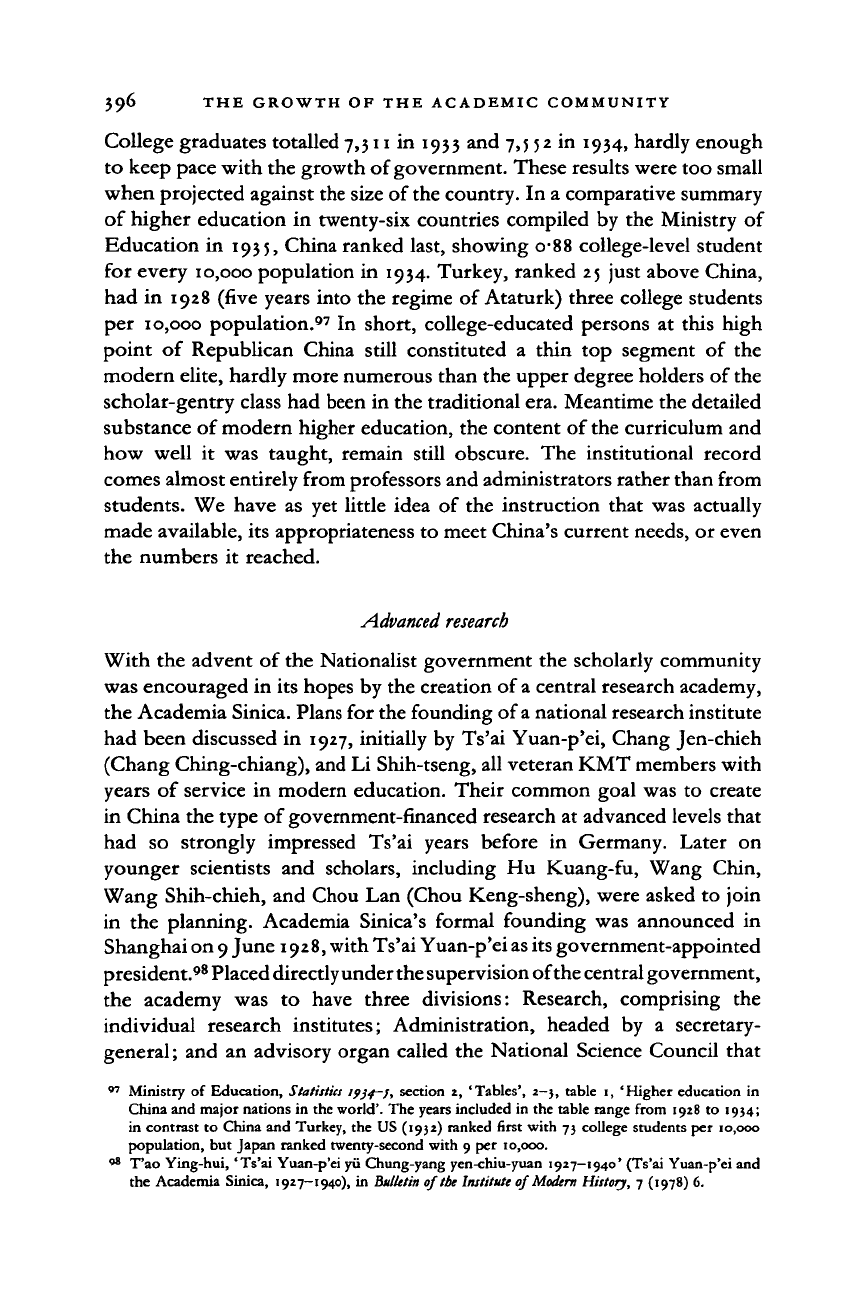
396 THE GROWTH OF THE ACADEMIC COMMUNITY
College graduates totalled 7,311 in 1933 and 7,5
52
in 1934, hardly enough
to keep pace with the growth of government. These results were too small
when projected against the size of
the
country. In a comparative summary
of higher education in twenty-six countries compiled by the Ministry of
Education in 1935, China ranked last, showing o-88 college-level student
for every 10,000 population in 1934. Turkey, ranked 25 just above China,
had in 1928 (five years into the regime of Ataturk) three college students
per 10,000 population.
97
In short, college-educated persons at this high
point of Republican China still constituted a thin top segment of the
modern elite, hardly more numerous than the upper degree holders of the
scholar-gentry class had been in the traditional era. Meantime the detailed
substance of modern higher education, the content of the curriculum and
how well it was taught, remain still obscure. The institutional record
comes almost entirely from professors and administrators rather than from
students. We have as yet little idea of the instruction that was actually
made available, its appropriateness to meet China's current needs, or even
the numbers it reached.
Advanced
research
With the advent of the Nationalist government the scholarly community
was encouraged in its hopes by the creation of
a
central research academy,
the Academia Sinica. Plans for the founding of a national research institute
had been discussed in 1927, initially by Ts'ai Yuan-p'ei, Chang Jen-chieh
(Chang Ching-chiang), and Li Shih-tseng, all veteran KMT members with
years of service in modern education. Their common goal was to create
in China the type of government-financed research at advanced levels that
had so strongly impressed Ts'ai years before in Germany. Later on
younger scientists and scholars, including Hu Kuang-fu, Wang Chin,
Wang Shih-chieh, and Chou Lan (Chou Keng-sheng), were asked to join
in the planning. Academia Sinica's formal founding was announced in
Shanghai on
9
June
1928,
with Ts'ai Yuan-p'ei
as
its government-appointed
president.
98
Placed directly under the supervision of the central government,
the academy was to have three divisions: Research, comprising the
individual research institutes; Administration, headed by a secretary-
general
;
and an advisory organ called the National Science Council that
97
Ministry of Education, Statistics ipjf-j, section 2, 'Tables', 2-3, table 1, 'Higher education in
China and major nations in the world'. The years included in the table range from 1928 to 1934;
in contrast to China and Turkey, the US (1932) ranked first with 73 college students per 10,000
population, but Japan ranked twenty-second with 9 per 10,000.
98
Tao Ying-hui, 'Ts'ai Yuan-p'ei yii Chung-yang yen-chiu-yuan 1927-1940* (Ts'ai Yuan-p'ei and
the Academia Sinica, 1927—1940), in Bulletin of
the
Institute of Modem History, 7 (1978) 6.
Cambridge Histories Online © Cambridge University Press, 2008
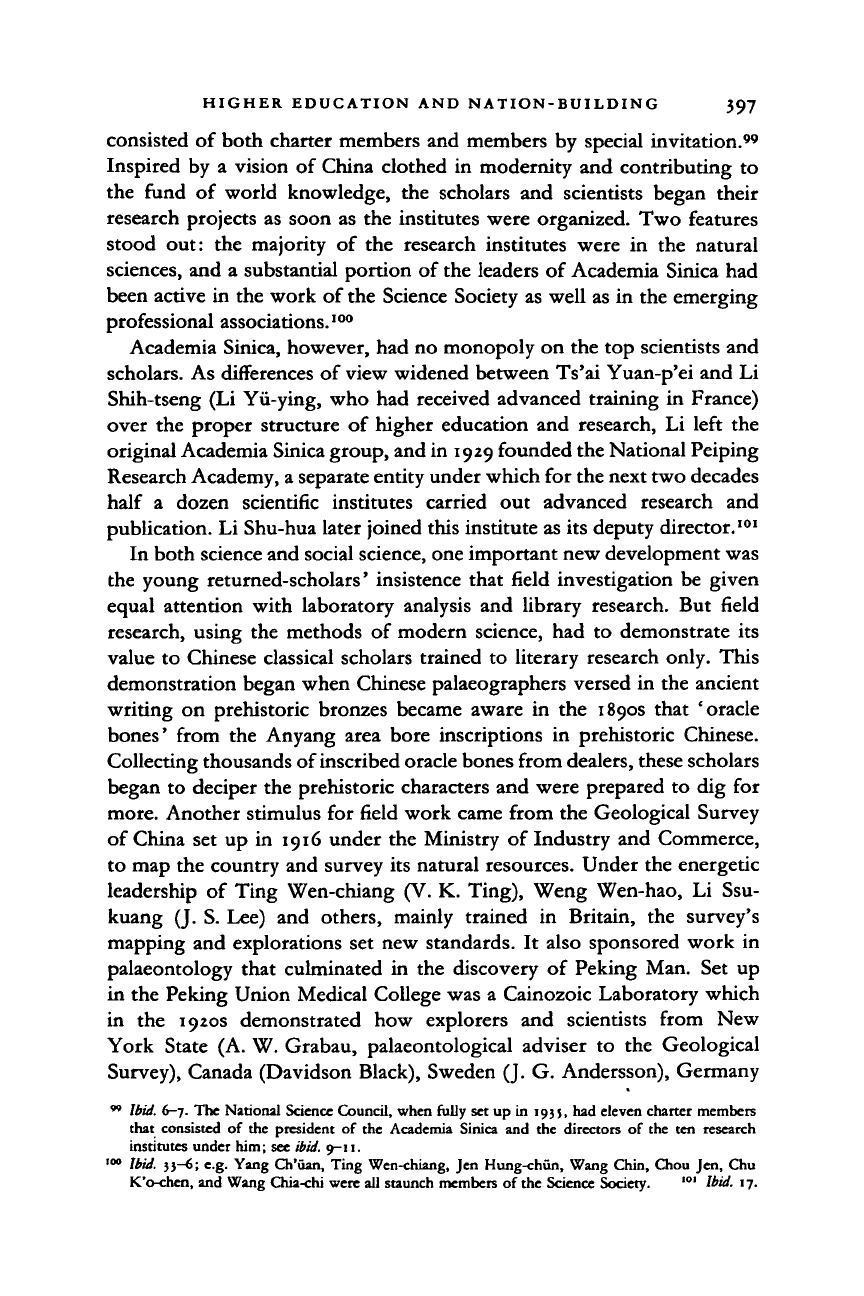
HIGHER EDUCATION AND NATION-BUILDING 397
consisted
of
both charter members and members by special invitation."
Inspired by
a
vision
of
China clothed
in
modernity and contributing
to
the fund
of
world knowledge,
the
scholars
and
scientists began their
research projects as soon as the institutes were organized. Two features
stood out:
the
majority
of
the research institutes were
in the
natural
sciences, and
a
substantial portion of the leaders of Academia Sinica had
been active in the work of the Science Society as well as in the emerging
professional associations.
100
Academia Sinica, however, had no monopoly on the top scientists and
scholars. As differences of view widened between Ts'ai Yuan-p'ei and Li
Shih-tseng (Li Yii-ying, who had received advanced training
in
France)
over the proper structure
of
higher education and research,
Li
left
the
original Academia Sinica group, and in 1929 founded the National Peiping
Research Academy, a separate entity under which for the next two decades
half
a
dozen scientific institutes carried
out
advanced research
and
publication. Li Shu-hua later joined this institute as its deputy director.
I01
In both science and social science, one important new development was
the young returned-scholars' insistence that field investigation be given
equal attention with laboratory analysis and library research.
But
field
research, using the methods
of
modern science, had
to
demonstrate
its
value
to
Chinese classical scholars trained
to
literary research only. This
demonstration began when Chinese palaeographers versed in the ancient
writing
on
prehistoric bronzes became aware
in the
1890s that 'oracle
bones'
from
the
Anyang area bore inscriptions
in
prehistoric Chinese.
Collecting thousands of inscribed oracle bones from dealers, these scholars
began to deciper the prehistoric characters and were prepared
to
dig
for
more. Another stimulus for field work came from the Geological Survey
of China set up
in
1916 under the Ministry
of
Industry and Commerce,
to map the country and survey its natural resources. Under the energetic
leadership
of
Ting Wen-chiang (V. K. Ting), Weng Wen-hao,
Li
Ssu-
kuang (J. S. Lee)
and
others, mainly trained
in
Britain,
the
survey's
mapping and explorations set new standards.
It
also sponsored work
in
palaeontology that culminated
in
the discovery
of
Peking Man. Set
up
in the Peking Union Medical College was
a
Cainozoic Laboratory which
in
the
1920s demonstrated
how
explorers
and
scientists from
New
York State (A. W. Grabau, palaeontological adviser
to the
Geological
Survey), Canada (Davidson Black), Sweden (J. G. Andersson), Germany
99
Ibid.
6-7. The National Science Council, when fully set up in 1935, had eleven charter members
that consisted
of
the president
of
the Academia Sinica and
the
directors
of
the
ten
research
institutes under him; see
ibid.
9-11.
100
Ibid.
33-6; e.g. Yang Ch'uan, Ting Wen-chiang, Jen Hung-chiin, Wang Chin, Chou Jen, Chu
K'o-chcn, and Wang Chia-chi were all staunch members of the Science Society.
""
Ibid.
17.
Cambridge Histories Online © Cambridge University Press, 2008
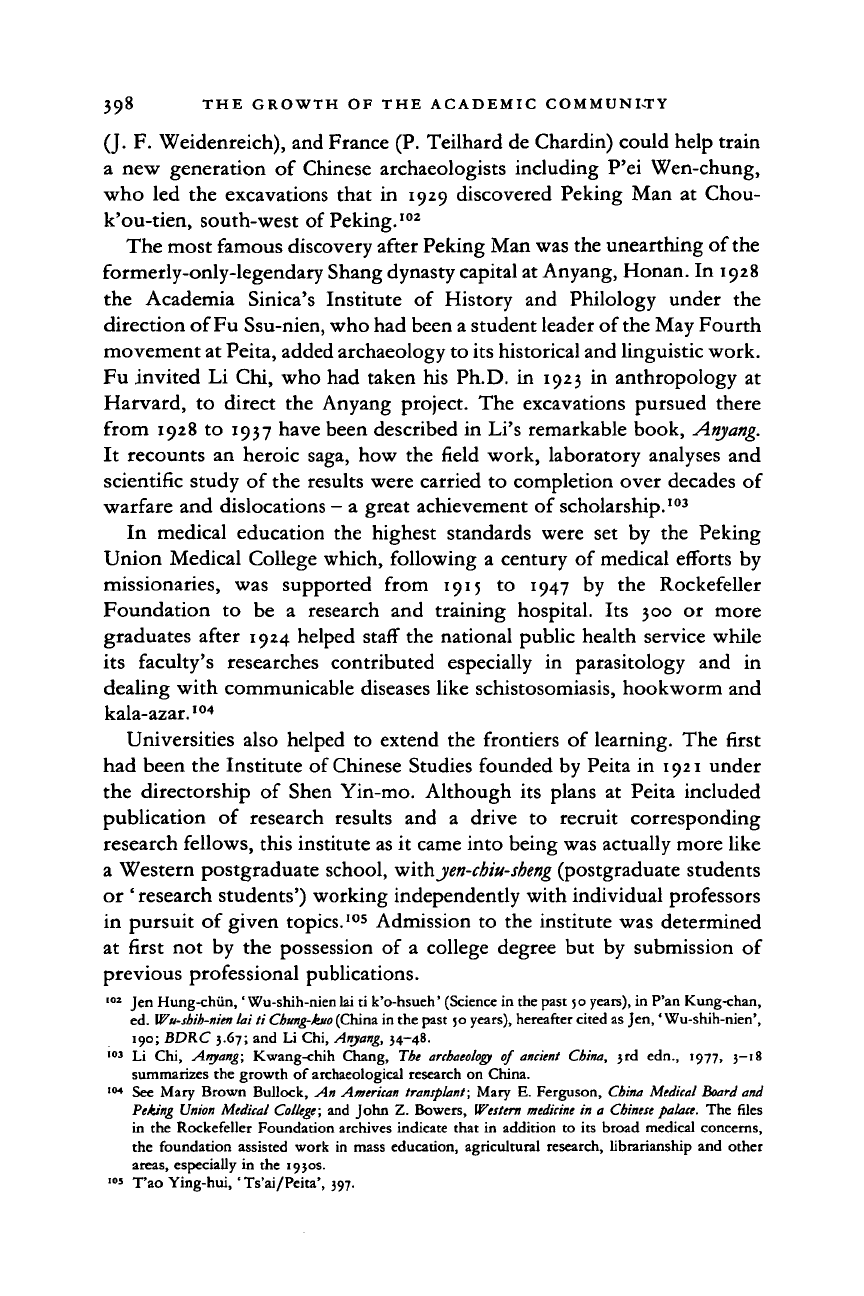
398 THE GROWTH OF THE ACADEMIC COMMUNITY
(J.
F.
Weidenreich),
and
France (P. Teilhard
de
Chardin) could help train
a
new
generation
of
Chinese archaeologists including
P'ei
Wen-chung,
who
led the
excavations that
in
1929
discovered Peking
Man
at
Chou-
k'ou-tien, south-west
of
Peking.
I02
The most famous discovery after Peking Man was
the
unearthing of the
formerly-only-legendary Shang dynasty capital
at
Anyang, Honan.
In 1928
the Academia Sinica's Institute
of
History
and
Philology under
the
direction of Fu Ssu-nien, who
had
been
a
student leader
of
the
May Fourth
movement
at
Peita, added archaeology
to
its historical
and
linguistic work.
Fu invited
Li
Chi, who had
taken
his Ph.D.
in
1923
in
anthropology
at
Harvard,
to
direct
the
Anyang project.
The
excavations pursued there
from
1928
to
1937
have been described
in Li's
remarkable book, Anyang.
It recounts
an
heroic saga,
how the
field work, laboratory analyses
and
scientific study
of the
results were carried
to
completion over decades
of
warfare
and
dislocations
-
a
great achievement
of
scholarship.
103
In medical education
the
highest standards were
set by the
Peking
Union Medical College which, following
a
century
of
medical efforts
by
missionaries,
was
supported from
1915 to
1947
by the
Rockefeller
Foundation
to be a
research
and
training hospital.
Its
300
or
more
graduates after
1924
helped staff
the
national public health service while
its faculty's researches contributed especially
in
parasitology
and in
dealing with communicable diseases like schistosomiasis, hookworm
and
kala-azar.
104
Universities also helped
to
extend
the
frontiers
of
learning.
The
first
had been
the
Institute
of
Chinese Studies founded
by
Peita
in
1921 under
the directorship
of
Shen Yin-mo. Although
its
plans
at
Peita included
publication
of
research results
and a
drive
to
recruit corresponding
research fellows, this institute
as
it
came into being was actually more like
a Western postgraduate school, withyen-chiu-sheng (postgraduate students
or ' research students') working independently with individual professors
in pursuit
of
given topics.
I0S
Admission
to
the
institute
was
determined
at first
not by
the
possession
of a
college degree
but
by
submission
of
previous professional publications.
102
Jen Hung-chiin,' Wu-shih-nien lai
ti
k'o-hsueh' (Science
in
the past 5 o years),
in
P'an Kung-chan,
ed. Wu-shih-nien
lai
ti
Cbung-kuo (China in the past 50 years), hereafter cited as Jen,' Wu-shih-nien',
190;
BDRC 3.67;
and
Li
Chi, Anyang, 34—48.
103
Li
Chi,
Anyang; Kwang-chih Chang,
The
archaeology
of
ancient China,
3rd
edn., 1977,
3-18
summarizes
the
growth
of
archaeological research
on
China.
104
See
Mary Brown Bullock,
An
American transplant; Mary
E.
Ferguson, China Medical Board and
Peking Union Medical College;
and
John
Z.
Bowers, Western medicine
in
a
Chinese palace.
The
files
in
the
Rockefeller Foundation archives indicate that
in
addition
to its
broad medical concerns,
the foundation assisted work
in
mass education, agricultural research, librarianship
and
other
areas,
especially
in
the
1930s.
105
Tao Ying-hui,
'
Ts'ai/Peita', 397.
Cambridge Histories Online © Cambridge University Press, 2008

HIGHER EDUCATION AND NATION-BUILDING 399
Ideals, enthusiasm, and expert planning aside, the work of
the
academic
community in the 1920s still encountered a frequent obstacle, inadequate
financial support. More than one contemporary record refers to this in
a matter-of-fact tone: ' China being in the midst of civil war, government
colleges and universities suffered from arrears in receipt of budgeted
revenues...
>I06
In order to make ends meet some professors had to teach
at two or more institutions simultaneously. In such circumstances, getting
allocations for research would be difficult, and so assistance from friends
and from outside sources could be crucial.
The sociology of knowledge may be expected to benefit from detailed
studies of the personnel configurations, groups, factions and cliques that
advanced modern learning in Republican China. To begin with, the small
elite of students abroad followed tradition by forming student fraternities
or associations
{hui)
for mutual support among themselves. Quite different
in aim and style from the secret society lodge
{tongs)
among Chinatown
merchants, these student fraternities selected and counselled junior
members, convened summer retreats, and formed personal bonds of trust
and friendship that could be of
use
later on in China. Best known of these
several groups was CCH (abbreviated from Ch'eng-chih hui, an
'association for the achievement of one's life goals', also known as 'Cross
and Sword').
107
On their return to China the young Ph.D.s became professors committed,
like all professors, to reproducing themselves; a fortunate few in
university institutes for advanced research were able to pursue their
specialities, while younger students who assisted them received training.
Peita, Tsing-hua, and Yenching in the Peking area, and Chung-shan
University and Lingnan in Canton, for example, set up specialized
research institutes and the results, generally of high quality, were
published in their own academic journals.
Among the outstanding institutes of this type was the Nankai Institute
of Economics, established in 1931 under the leadership of Franklin Ho
(Ho Lien), who as professor of public finance and statistics at Nankai
University was also pioneering Nankai's systematic studies of North China
industries. This charted a new direction in the teaching of economics in
China; instead of using Western experience and examples, the study of
Chinese economic life was not based on data gathered from within the
106
H. D.
Fong, Reminiscences of a Chinese economist
at
70, 31.
107
Now
no
longer secret, CCH published
a
history and directory.
Its
membership included
Chi
Ch'ao-ting, Chiang T'ing-fu (T.
F.
Tsiang), Chiang Meng-lin (Monlin), Fang Hsien-t'ing
(H.
D.
Fong),
Ho
Lien (Franklin Ho), K'ung Hsiang-hsi (H.
H.
Kung), Kuo Ping-wen, Meng
Chih (Paul Mcng), Tsou Ping-wen, Weng Wan-ko (Wango Weng), Yen Yang-ch'u (Y. C. James
Yen).
Personal communication from Wango Weng, August 1979.
Cambridge Histories Online © Cambridge University Press, 2008
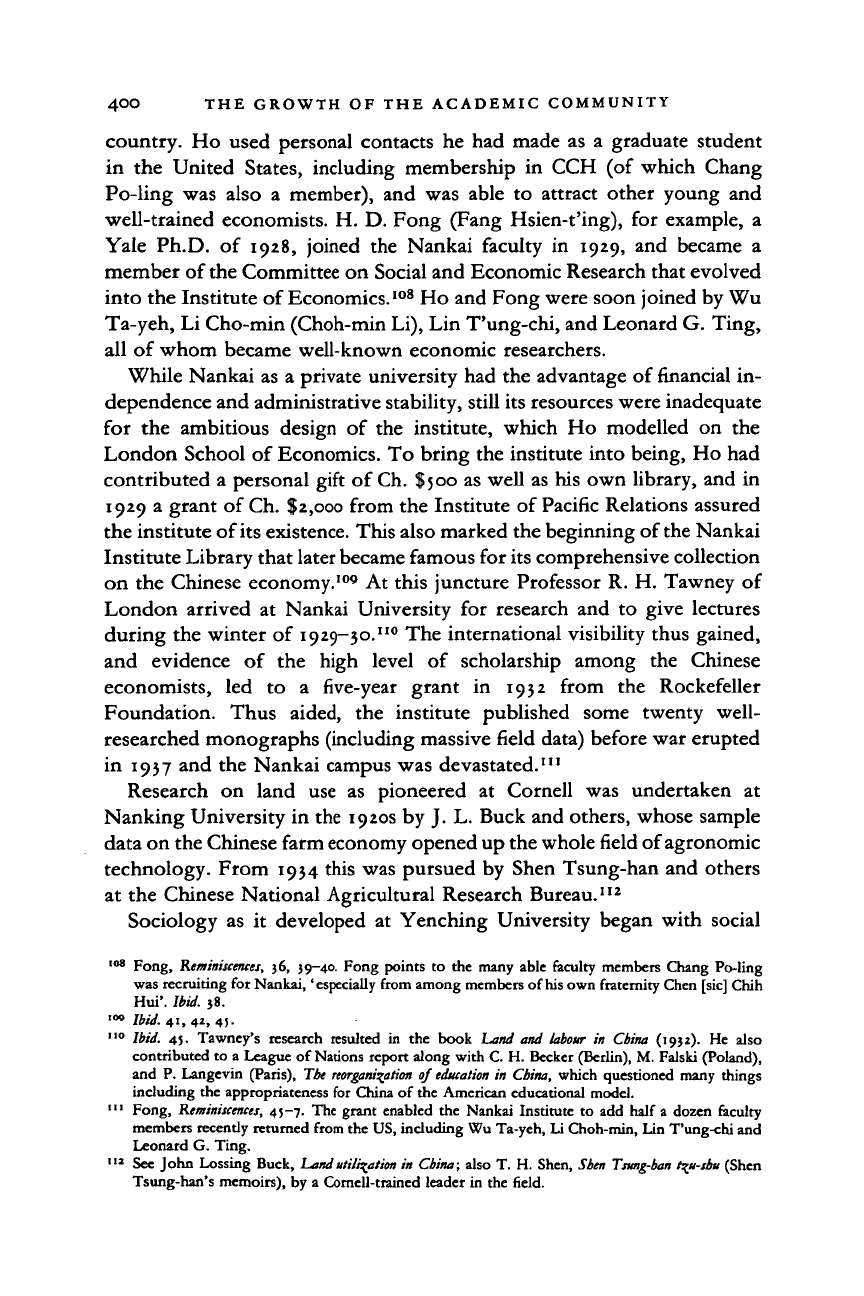
4°O THE GROWTH OF THE ACADEMIC COMMUNITY
country. Ho used personal contacts he had made as a graduate student
in the United States, including membership in CCH (of which Chang
Po-ling was also a member), and was able to attract other young and
well-trained economists. H. D. Fong (Fang Hsien-t'ing), for example, a
Yale Ph.D. of 1928, joined the Nankai faculty in 1929, and became a
member of the Committee on Social and Economic Research that evolved
into the Institute of Economics.
108
Ho and Fong were soon joined by Wu
Ta-yeh, Li Cho-min (Choh-min Li), Lin T'ung-chi, and Leonard G. Ting,
all of whom became well-known economic researchers.
While Nankai as a private university had the advantage of financial in-
dependence and administrative stability, still its resources were inadequate
for the ambitious design of the institute, which Ho modelled on the
London School of Economics. To bring the institute into being, Ho had
contributed a personal gift of
Ch.
$500 as well as his own library, and in
1929 a grant of
Ch.
$2,000 from the Institute of Pacific Relations assured
the institute of its existence. This also marked the beginning of
the
Nankai
Institute Library that later became famous for its comprehensive collection
on the Chinese economy.
109
At this juncture Professor R. H. Tawney of
London arrived at Nankai University for research and to give lectures
during the winter of 1929-30.
110
The international visibility thus gained,
and evidence of the high level of scholarship among the Chinese
economists, led to a five-year grant in 1932 from the Rockefeller
Foundation. Thus aided, the institute published some twenty well-
researched monographs (including massive field data) before war erupted
in 1937 and the Nankai campus was devastated.
111
Research on land use as pioneered at Cornell was undertaken at
Nanking University in the 1920s by J. L. Buck and others, whose sample
data on the Chinese farm economy opened up the whole field of agronomic
technology. From 1934 this was pursued by Shen Tsung-han and others
at the Chinese National Agricultural Research Bureau.
112
Sociology as it developed at Yenching University began with social
108
Fong, Reminiscences,
36,
39-40. Fong points
to the
many able faculty members Chang Po-ling
was recruiting
for
Nankai, 'especially from among members
of
his
own
fraternity Chen
[sic]
Chih
Hui'.
Ibid. 38.
109
Ibid. 41, 42, 4j.
110
Ibid.
45. Tawney's research resulted in the book hand and
labour
in China (1932). He also
contributed to a League of Nations report along with C. H. Becker (Berlin), M. Falski (Poland),
and P. Langevin (Paris),
The
reorganisation
of
education
in
China,
which questioned many things
including the appropriateness for China of the American educational model.
111
Fong,
Reminiscences,
45-7. The grant enabled the Nankai Institute to add half a dozen faculty
members
recently
returned
from the US, including Wu Ta-yeh, Li Choh-min, Lin T'ung-chi and
Leonard G. Ting.
112
Sec John Lossing Buck,
Land utilisation
in
China;
also T. H. Shen,
Sben Tsung-han
t^u-sbu
(Shen
Tsung-han's memoirs), by a Cornell-trained leader in the field.
Cambridge Histories Online © Cambridge University Press, 2008
